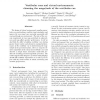Free Online Productivity Tools
i2Speak
i2Symbol
i2OCR
iTex2Img
iWeb2Print
iWeb2Shot
i2Type
iPdf2Split
iPdf2Merge
i2Bopomofo
i2Arabic
i2Style
i2Image
i2PDF
iLatex2Rtf
Sci2ools
71
Voted
VR
1999
IEEE
1999
IEEE
Vestibular Cues and Virtual Environments: Choosing the Magnitude of the Vestibular Cue
The design of virtual environments usually concentrates on constructing a realistic visual simulation and ignores the non-visual cues normally associated with moving through an environment. The lack of the normal complement of cues may contribute to cybersickness and may a ect operator performance. In 3 we described the e ect of adding vestibular cues during passive linear motion and showed an unexpected dominance of the vestibular cue in determining the magnitude of the perceived motion. Here we vary the relative magnitude of the visual and vestibular cues and describe a simple linear summation model that predicts the resulting perceived magnitude of motion. The model suggests that designers of virtual reality displays should add vestibular information in a ratio of one to four with the visual motion to obtain convincing and accurate performance.
| Added | 04 Aug 2010 |
| Updated | 04 Aug 2010 |
| Type | Conference |
| Year | 1999 |
| Where | VR |
| Authors | Laurence R. Harris, Michael Jenkin, Daniel C. Zikovitz |
Comments (0)

